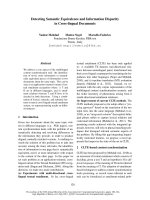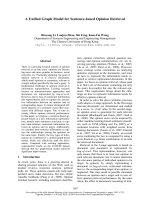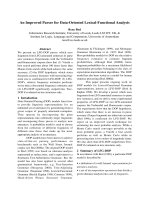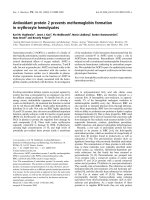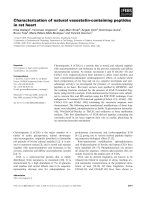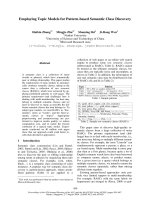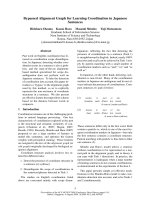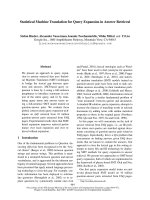Báo cáo khoa học: "Bypassed Alignment Graph for Learning Coordination in Japanese Sentences" doc
Bạn đang xem bản rút gọn của tài liệu. Xem và tải ngay bản đầy đủ của tài liệu tại đây (481.19 KB, 4 trang )
Proceedings of the ACL-IJCNLP 2009 Conference Short Papers, pages 5–8,
Suntec, Singapore, 4 August 2009.
c
2009 ACL and AFNLP
Bypassed Alignment Graph for Learning Coordination in Japanese
Sentences
Hideharu Okuma Kazuo Hara Masashi Shimbo Yuji Matsumoto
Graduate School of Information Science
Nara Institute of Science and Technology
Ikoma, Nara 630-0192, Japan
{okuma.hideharu01,kazuo-h,shimbo,matsu}@is.naist.jp
Abstract
Past work on English coordination has fo-
cused on coordination scope disambigua-
tion. In Japanese, detecting whether coor-
dination exists in a sentence is also a prob-
lem, and the state-of-the-art alignment-
based method specialized for scope dis-
ambiguation does not perform well on
Japanese sentences. To take the detection
of coordination into account, this paper in-
troduces a ‘bypass’ to the alignment graph
used by this method, so as to explicitly
represent the non-existence of coordinate
structures in a sentence. We also present
an effective feature decomposition scheme
based on the distance between words in
conjuncts.
1 Introduction
Coordination remains one of the challenging prob-
lems in natural language processing. One key
characteristic of coordination explored in the past
is the structural and semantic symmetry of con-
juncts (Chantree et al., 2005; Hogan, 2007;
Resnik, 1999). Recently, Shimbo and Hara (2007)
proposed to use a large number of features to
model this symmetry, and optimize the feature
weights with perceptron training. These features
are assigned to the arcs of the alignment graph (or
edit graph) originally developed for biological se-
quence alignment.
Coordinate structure analysis involves two re-
lated but different tasks:
1. Detect the presence of coordinate structure in
a sentence (or a phrase).
2. Disambiguate the scope of coordinations in
the sentences/phrases detected in Task 1.
The studies on English coordination listed
above are concerned mainly with scope disam-
biguation, reflecting the fact that detecting the
presence of coordinations in a sentence (Task 1)
is straightforward in English. Indeed, nearly 100%
precision and recall can be achieved in Task 1 sim-
ply by pattern matching with a small number of
coordination markers such as “and,” “or,” and “as
well as”.
In Japanese, on the other hand, detecting coor-
dination is non-trivial. Many of the coordination
markers in Japanese are ambiguous and do not al-
ways indicate the presence of coordinations. Com-
pare sentences (1) and (2) below:
rondon to pari ni itta
(London) (and) (Paris) (to) (went)
(I went to London and Paris)
(1)
kanojo to pari ni itta
(her) (with) (Paris) (to) (went)
(I went to Paris with her)
(2)
These sentences differ only in the first word. Both
contain a particle to, which is one of the most fre-
quent coordination markers in Japanese—but only
the first sentence contains a coordinate structure.
Pattern matching with particle to thus fails to filter
out sentence (2).
Shimbo and Hara’s model allows a sentence
without coordinations to be represented as a nor-
mal path in the alignment graph, and in theory it
can cope with Task 1 (detection). In practice, the
representation is inadequate when a large number
of training sentences do not contain coordinations,
as demonstrated in the experiments of Section 4.
This paper presents simple yet effective modi-
fications to the Shimbo-Hara model to take coor-
dination detection into account, and solve Tasks 1
and 2 simultaneously.
5
a
policeman
and
warehouse
guard
a
policeman
and
warehouse
guard
a
policeman
and
warehouse
guard
a
policeman
and
warehouse
guard
(a) Alignment graph (b) Path 1
a
policeman
and
warehouse
guard
a
policeman
and
warehouse
guard
a
policeman
and
warehouse
guard
a
policeman
and
warehouse
guard
(c) Path 2 (d) Path 3 (no coordination)
Figure 1: Alignment graph for “a policeman and
warehouse guard” ((a)), and example paths repre-
senting different coordinate structure ((b)–(d)).
2 Alignment-based coordinate structure
analysis
We first describe Shimbo and Hara’s method upon
which our improvements are made.
2.1 Triangular alignment graph
The basis of their method is a triangular align-
ment graph, illustrated in Figure 1(a). Kurohashi
and Nagao (1994) used a similar data structure in
their rule-based method. Given an input sentence,
the rows and columns of its alignment graph are
associated with the words in the sentence. Un-
like the alignment graph used in biological se-
quence alignment, the graph is triangular because
the same sentence is associated with rows and
columns. Three types of arcs are present in the
graph. A diagonal arc denotes coordination be-
tween the word above the arc and the one on the
right; the horizontal and vertical arcs represent
skipping of respective words.
Coordinate structure in a sentence is repre-
sented by a complete path starting from the top-
left (initial) node and arriving at the bottom-right
(terminal) node in its alignment graph. Each arc
in this path is labeled either
Inside
or
Outside
de-
pending on whether its span is part of coordina-
tion or not; i.e., the horizontal and vertical spans
of an
Inside
segment determine the scope of two
conjuncts. Figure 1(b)–(d) depicts example paths.
Inside
and
Outside
arcs are depicted by solid and
dotted lines, respectively. Figure 1(b) shows a
path for coordination between “policeman” (ver-
tical span of the
Inside
segment) and “warehouse
guard” (horizontal span). Figure 1(c) is for “po-
liceman” and “warehouse.” Non-existence of co-
ordinations in a sentence is represented by the
Outside
-only path along the top and the rightmost
borders of the graph (Figure 1(d)).
With this encoding of coordinations as paths,
coordinate structure analysis can be reduced to
finding the highest scoring path in the graph,
where the score of an arc is given by a measure
of how much two words are likely to be coordi-
nated. The goal is to build a measure that assigns
the highest score to paths denoting the correct co-
ordinate structure. Shimbo and Hara defined this
measure as a linear function of many features as-
sociated to arcs, and used perceptron training to
optimize the weight coefficients for these features
from corpora.
2.2 Features
For the description of features used in our adap-
tation of the Shimbo-Hara model to Japanese, see
(Okuma et al., 2009). In this model, all features
are defined as indicator functions asking whether
one or more attributes (e.g., surface form, part-of-
speech) take specific values at the neighbor of an
arc. One example of a feature assigned to a diag-
onal arc at row i and column j of the alignment
graph is
f =
⎧
⎨
⎩
1if
POS[i]=Noun, POS[ j]=Adjective,
and the label of the arc is
Inside
,
0 otherwise.
where
POS[i] denotes the part-of-speech of the ith
word in a sentence.
3 Improvements
We introduce two modifications to improve the
performance of Shimbo and Hara’s model in
Japanese coordinate structure analysis.
3.1 Bypassed alignment graphs
In their model, a path for a sentence with no coor-
dination is represented as a series of
Outside
arcs
as we saw in Figure 1(d). However,
Outside
arcs
also appear in partial paths between two coordina-
tions, as illustrated in Figure 2. Thus, two differ-
6
A
and
B
are
X
and
Y
A
and
B
are
X
and
Y
Figure 2: Original alignment graph for sentence
with two coordinations. Notice that
Outside
(dot-
ted) arcs connect two coordinations
Figure 3: alignment graph with a “bypass”
ent roles are given to
Outside
arcs in the original
Shimbo-Hara model.
We identify this to be a cause of their model not
performing well for Japanese, and propose to aug-
ment the original alignment graph with a “bypass”
devoted to explicitly indicate that no coordination
exists in a sentence; i.e., we add a special path di-
rectly connecting the initial node and the terminal
node of an alignment graph. See Figure 3 for il-
lustration of a bypass.
In the new model, if the score of the path
through the bypass is higher than that of any paths
in the original alignment graph, the input sentence
is deemed not containing coordinations.
We assign to the bypass two types of features
capturing the characteristics of a whole sentence;
i.e., indicator functions of sentence length, and of
the existence of individual particles in a sentence.
The weight of these features, which eventually de-
termines the score of the bypass, is tuned by per-
ceptron just like the weights of other features.
3.2 Making features dependent on the
distance between conjuncts
Coordinations of different type (e.g., nominal and
verbal) have different relevant features, as well as
different average conjunct length (e.g., nominal
coordinations are shorter).
This observation leads us to our second modi-
fication: to make all features dependent on their
occurring positions in the alignment graph. To be
precise, for each individual feature in the original
model, a new feature is introduced which depends
on whether the Manhattan distance d in the align-
ment graph between the position of the feature oc-
currence and the nearest diagonal exceeds a fixed
threshold
1
θ
. For instance, if a feature f is an in-
dicator function of condition X, a new feature f
is
introduced such that
f
=
1, if d ≤
θ
and condition X holds,
0, otherwise.
Accordingly, different weights are learned and as-
sociated to two features f and f
. Notice that the
Manhattan distance to the nearest diagonal is equal
to the distance between word pairs to which the
feature is assigned, which in turn is a rough esti-
mate of the length of conjuncts.
This distance-based decomposition of features
allows different feature weights to be learned for
coordinations with conjuncts shorter than or equal
to
θ
, and those which are longer.
4 Experimental setup
We applied our improved model and Shimbo and
Hara’s original model to the EDR corpus (EDR,
1995). We also ran the Kurohashi-Nagao parser
(KNP) 2.0
2
, a widely-used Japanese dependency
parser to which Kurohashi and Nagao’s ( 1994)
rule-based coordination analysis method is built
in. For comparison with KNP, we focus on bun-
setsu-level coordinations. A bunsetsu is a chunk
formed by a content word followed by zero or
more non-content words like particles.
4.1 Dataset
The Encyclopedia section of the EDR corpus was
used for evaluation. In this corpus, each sentence
is segmented into words and is accompanied by a
syntactic dependency tree, and a semantic frame
representing semantic relations among words.
A coordination is indicated by a specific relation
of type “and” in the semantic frame. The scope of
conjuncts (where a conjunct may be a word, or a
series of words) can be obtained by combining this
information with that of the syntactic tree. The
detail of this procedure can be found in (Okuma et
al., 2009).
1
We use
θ
= 5 in the experiments of Section 4.
2
/>7
Table 1: Accuracy of coordination scopes and end of conjuncts, averaged over five-fold cross validation.
The numbers in brackets are the improvements (in points) relative to the Shimbo-Hara (SH) method.
Scope of coordinations End of conjuncts
Method Precision Recall F1 measure Precision Recall F1 measure
KNP n/a n/a n/a 58.8 65.3 61.9 (−2.6)
Shimbo and Hara’s method (SH; baseline) 53.7 49.8 51.6 (±0.0) 67.0 62.1 64.5 (±0.0)
SH + distance-based feature decomposition 55.3 52.1 53.6 (+2.0) 68.3 64.3 66.2 (+1.7)
SH + distance-based feature decomposition + bypass 55.0 57.6 56.3 (+4.7) 66.8 69.9 68.3 (+3.8)
Of 10,072 sentences in the Encyclopedia sec-
tion, 5,880 sentences contain coordinations. We
excluded 1,791 sentences in which nested coordi-
nations occur, as these cannot be processed with
Shimbo and Hara’s method (with or without our
improvements).
We then applied Japanese morphological ana-
lyzer JUMAN 5.1 to segment each sentence into
words and annotate them with parts-of-speech,
and KNP with option ’-bnst’ to transform the se-
ries of words into a bunsetsu series. With this
processing, each word-level coordination pair is
also translated into a bunsetsu pair, unless the
word-level pair is concatenated into a single bun-
setsu (sub-bunsetsu coordination). Removing sub-
bunsetsu coordinations and obvious annotation er-
rors left us with 3,257 sentences with bunsetsu-
level coordinations. Combined with the 4,192 sen-
tences not containing coordinations, this amounts
to 7,449 sentences used for our evaluation.
4.2 Evaluation metrics
KNP outputs dependency structures in Kyoto Cor-
pus format (Kurohashi et al., 2000) which spec-
ifies the end of coordinating conjuncts (bunsetsu
sequences) but not their beginning.
Hence two evaluation criteria were employed:
(i) correctness of coordination scopes
3
(for com-
parison with Shimbo-Hara), and (ii) correctness of
the end of conjuncts (for comparison with KNP).
We report precision, recall and F1 measure, with
the main performance index being F1 measure.
5 Results
Table 1 summarizes the experimental results.
Even Shimbo and Hara’s original method (SH)
outperformed KNP. KNP tends to output too many
coordinations, yielding a high recall but low pre-
cision. By contrast, SH outputs a smaller number
3
A coordination scope is deemed correct only if the brack-
eting of constituent conjuncts are all correct.
of coordinations; this yields a high precision but a
low recall.
The distance-based feature decomposition of
Section 3.2 gave +2.0 points improvement over the
original SH in terms of F1 measure in coordination
scope detection. Adding bypasses to alignment
graphs further improved the performance, making
a total of +4.7 points in F1 over SH; recall signifi-
cantly improved, with precision remaining mostly
intact. Finally, the improved model (SH + decom-
position + bypass) achieved an F1 measure +6.4
points higher than that of KNP in terms of end-of-
conjunct identification.
References
F. Chantree, A. Kilgarriff, A. de Roeck, and A. Willis.
2005. Disambiguating coordinations using word
distribution information. In Proc. 5th RANLP.
EDR, 1995. The EDR dictionary. NICT. http://www2.
nict.go.jp/r/r312/EDR/index.html.
D. Hogan. 2007. Coordinate noun phrase disambigua-
tion in a generative parsing model. In Proc. 45th
ACL, pages 680–687.
S. Kurohashi and M. Nagao. 1994. A syntactic analy-
sis method of long Japanese sentences based on the
detection of conjunctive structures. Comput. Lin-
guist., 20:507–534.
S. Kurohashi, Y. Igura, and M. Sakaguchi, 2000. An-
notation manual for a morphologically and sytac-
tically tagged corpus, Ver. 1.8. Kyoto Univ. In
Japanese. />corpus/KyotoCorpus4.0/doc/syn
guideline.pdf.
H. Okuma, M. Shimbo, K. Hara, and Y. Matsumoto.
2009. Bypassed alignment graph for learning coor-
dination in Japanese sentences: supplementary ma-
terials. Tech. report, Grad. School of Information
Science, Nara Inst. Science and Technology. http://
isw3.naist.jp/IS/TechReport/report-list.html#2009.
P. Resnik. 1999. Semantic similarity in a taxonomy. J.
Artif. Intel. Res., 11:95–130.
M. Shimbo and K. Hara. 2007. A discriminative learn-
ing model for coordinate conjunctions. In Proc.
2007 EMNLP/CoNLL, pages 610–619.
8
